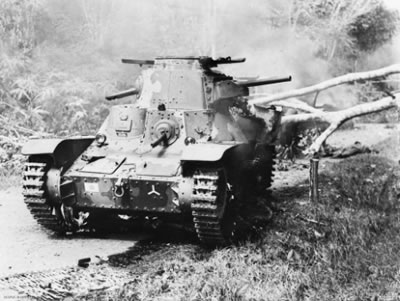The Type 95 Ha-Go light tank was the most commonly used Japanese tank in World War II. It was used in the Second Sino-Japanese War and against the Russians in Manchuria before World War II.
Between 1935 and 1943, about 1,350 Ha-Go light tanks were built.
A 6-cylinder, 120 horsepower diesel engine powered the Ha-Go light tank, which used clutch and brake steering. The Ha-Go had a sliding transmission which gave the tank four forward gears and one reverse gear. Its maximum speed was 28 miles per hour (45kph).
The Ha-Go mounted a 1.46 inch (37mm) main gun and a coaxial 0.303 inch (7.7mm) machine gun in the turret, which was offset to the left of the tank. There was another 0.303 inch (7.7mm) machine gun at the bow.

The superstructure stuck out over the tank’s tracks.
The Ha-Go was operated by three crewmen. The commander remained in the turret by himself, where he was responsible for loading and firing the turret guns. The driver and the bow machine gunner both sat in the hull.
An amphibious version of the Ha-Go was built for the Japanese Navy. It was designated the Type 2 Ka-Mi.
Type 95 Ha-Go Light |
|
|---|---|
| Active: | 1935 |
| Crew: | 3 |
| Weight: | 7.28 tons (7,400 kg) |
| Length: | 14ft 4.5in (4.38m) |
| Height: | 7ft 2in (2.18m) |
| Width: | 6ft 9in (2.06m) |
| Weapons: | Main – 1.46in (37mm) gun, Secondary – 2 x 0.303in (7.7mm) machineguns |
| Armor | Maximum – 0.47in (12mm) |
| Engine: | Mitsubishi NVD 6-cylinder diesel, 120hp |
| Speed: | 28mph (45kph) |
| Range: | 150.4 miles (242 km) |